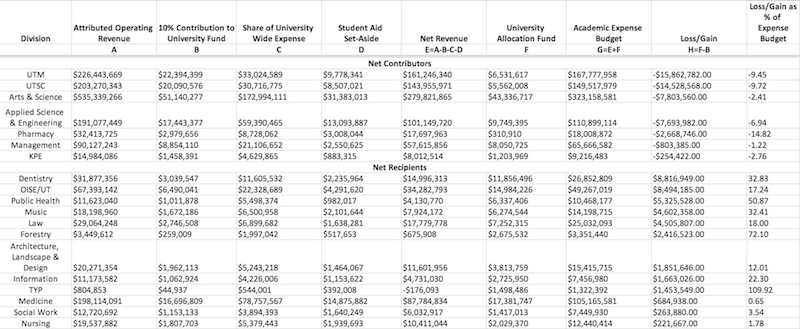U of T’s total budget is set to cross the $2 billion mark for the first time in 2014–2015, according to a report presented to the Business Board of Governing Council on Monday, March 3. Buried in that figure is over $40 million in within-university subsidies that will be transferred from undergraduate-heavy divisions of the university to graduate-heavy and revenue-poor divisions.
UTSC and the Faculty of Applied Science and Engineering give up the equivalent of 9.72 per cent and 6.94 per cent of their academic expense budget, respectively, through a budget mechanism called the University Fund. The Faculties of Dentistry and Forestry are among the net-recipients, taking in 32.83 and 72.10 per cent of their academic expense budgets respectively via the Fund (see table below).
Sally Garner, executive director of the university’s Planning and Budget Office, said that seeing the transfer between divisions as evidence that undergraduates “subsidize” graduates is too simplistic. “On average, that is probably true, but I think that’s too broad and too general because you could also say first- and second-year are subsidizing third- and fourth-year undergrads,” she explained.
“Although the university fund is a reality, we must participate in due to the nature of the New Budget Model; our students at UTM deserve more funding from the university,” said Hamza Ansari, vice-president, university affairs & academics of the University of Toronto Mississauga Students’ Union (UTMSU).
The University Fund
The University Fund mechanism is a result of a new budget model adopted by U of T in the 2006–2007 financial year, intended to increase transparency and improve decision-making.
The Fund is a 10 per cent ‘tax’ taken off a division’s attributed operating revenue. Each division is allocated a portion of the University Fund, with a fixed amount (totalling $100 million) having been set in the first year of the new model, and the rest distributed at the discretion of the provost.
Professor Scott Prudham, president of the University of Toronto Faculty Association (UTFA), suggested that the new budget model might create the false impression that each division of the university is financially independent. “[If] this way of looking at things creates the impression that Divisions are stand-alone fiscal entities whose budget deficits or surpluses are anything other than artifacts of administrative and subjective decisions within the University Administration, then that is unfortunate and incorrect,” he said.
“There are within-university subsidies,” admitted Scott Mabury, U of T’s vice-president, university operations. “We have never, nor will we ever going forward say to a division, ‘You have to exist entirely separate from the university as a whole and you have to completely be to your own devices.’”
Funding formula
George Luste is a former president of UTFA, and the author of a 2010 information report entitled How Undergraduates Subsidize Professional Faculties: A Look at UofT’s New Budget Model. “I think our university is financially dysfunctional because we are trying very hard to be an internationally competitive university… but we’re not funded in any different way than major undergraduate schools like Lakehead, or Trent,” he said.
A major reason for the cross-subsidy structure, according to Garner, is the provincial funding model. The province uses a system called Basic Income Units (BIUs) to determine how much funding to provide to universities based on their enrolment. BIU ‘weights’ are based on the perceived cost of education for different programs and disciplines.
Brad Duguid, Ontario’s minister of Training, Colleges and Universities, acknowledged that the BIU system needed revision. He suggested that a review of the province’s funding structure is set to take place over the summer, but that such discussions could not take place before strategic mandate agreements (SMAs) are finalized with the province’s universities. U of T president Meric Gertler indicated to Business Board last week that the university was in the process of finalizing its own SMA.
U of T’s provost Cheryl Regehr said the university has not officially been informed of proposed changes to the provincial funding formula, and would “have to have a look at what the government has in mind and see what the impacts of that will be.”
Duguid acknowledged that the BIU-based funding model encourages universities to grow to boost funding. “Throughout the system, you’ll see universities that are growing, but finding ways to grow even though they don’t need to, just to chase those growth dollars because the BIU incents them to do that,” he explained.
Enrolment growth has helped counteract what members of the university administration call chronic under-funding from the provincial government; enrolment accounts for 89 per cent of the university’s revenue. But Garner insisted the university is not growing for the sake of funding. “I wouldn’t say we’re increasing enrolment to deal with the financial picture; it is helping for now to deal with the financial picture but we’re increasing enrolment for other reasons,” she said. “Are we going to continue to grow enrolment just to make up for the declining grant? No.”
UTM
The University of Toronto Mississauga is the biggest net-contributor to the Fund, and is set to pay in $15.8 million more than it receives back in the upcoming financial year.
“In an ideal world I would like to keep all of the UF money at UTM, because our needs are huge,” admitted Deep Saini, principal and vice-president of UTM. “[But] while wishing that would happen, and while advocating every year for that to happen, we also as citizens of the University of Toronto recognize that it may not happen in the real world.”
“I understand that the allocation towards this fund has been decreasing at a slow pace since 2006, but we would like to see more of our money allocated towards UTM so that we can work closely with the UTM administration to better utilize student funding in order to continue and build our student services,” said Ansari.
Are subsidies inevitable?
Rick Halpern, dean and vice-principal, academic at UTSC suggested that students benefit from cross-subsidization because it allows U of T to attract world-class faculty, and provides a wider range of academic opportunities. “If we allowed one part of the university to suffer, if we were all going to just look after our own funds, the university’s reputation would begin a downward spiral,” he said.
Prudham pointed to the discretionary nature of the Fund as his chief concern. “From UTFA’s perspective, in a large, comprehensive University like this one, some level of subsidization of one division to another is normal and even desirable,” he said.
“The issue is not the fact of the subsidies or transfers between divisions. Rather, the issue is the magnitudes of those subsidies, whether those magnitudes are fair, and the processes by which decisions are made over those magnitudes.”
Regehr said that cross-subsidies will always exist. “[There] are certain divisions that will not be able to be financially independent,” she said, citing the Transitional Year Program as an example. Saini and Halpern both point out that the per-student value of the subsidy that their divisions pay out has reduced in recent years.
Duguid claimed the province cannot control cross-subsidies within university budgeting, but would discuss it if administrators raise the point during funding formula negotiations.
The proposed 2014–2015 Budget Report and Long Range Budge Guidelines 2014–15 to 2018–19 will be presented for approval to the university’s Governing Council at its April 8 meeting.



